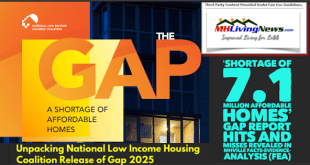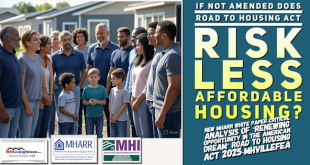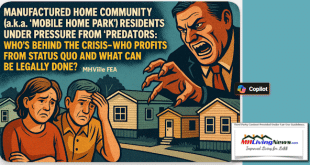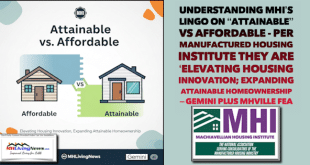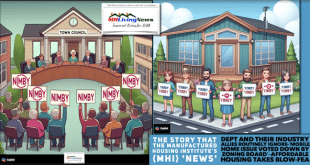During a well-documented affordable housing crisis, manufactured housing has finally risen beyond the 100,000 new homes produced threshold in 2021. The last time the manufactured home industry collectively produced over 100,000 homes was in 2006, when 117,373 new HUD Code manufactured homes were produced. A look at the most recent state and national level manufactured home production and shipment data will produce fresh information. When that new state and national information from official sources are coupled with insights from the Urban Institute and previous research reported here on Mobile and Manufactured Home Living News (MHLivingNews), this fact-packed and viewpoints (expert opinions) article and analysis will shed light on issues raised by the Urban Institute and others.
First, will be a look at the latest federal data. That will be followed by additional related and linked information, analysis, and expert commentary.
FOR IMMEDIATE RELEASE Contact: MHARR
(202) 783-4087
Manufactured Housing Production Growth Continues in March 2022
Washington, D.C., May 3, 2022 – The Manufactured Housing Association for Regulatory Reform (MHARR) reports that according to official statistics compiled on behalf of the U.S. Department of Housing and Urban Development (HUD), HUD Code manufactured housing industry year-over-year production increased in March 2022. Just-released statistics indicate that HUD Code manufacturers produced 11,279 homes in March 2022, a 12.7% increase over the 10,008 new HUD Code homes produced during March 2021. Cumulative production for 2022 now totals 29,670 homes, a 12% increase over the 26,479 homes produced during the same period in 2021.
A further analysis of the official industry statistics shows that the top ten shipment states from the beginning of the industry production rebound in August 2011 through March 2022 — with cumulative, monthly, current year (2022) and prior year (2021) shipments per category as indicated — are:
| Rank-State | Cumulative | Current Month (Mar. 2022) | 2022 | 2021 | |
| 1. Texas | 142,828 homes | 2,121 | 5,368 | 4,557 | |
| 2. Florida | 52,998 homes | 794 | 2,237 | 1,808 | |
| 3. Louisiana | 47,853 homes | 532 |
|
1,403 | |
| 4. North Carolina | 37,541 homes | 663 | 1,694 | 1,569 | |
| 5. Alabama | 36,052 homes | 528 | 1,465 | 1,328 | |
| 6. Mississippi | 30,070 homes | 457 | 1,163 | 1,067 | |
| 7. Michigan | 29,023 homes | 276 | 1,019 | 919 | |
| 8. California | 28,624 homes | 362 | 955 | 784 | |
| 9. Kentucky | 27,016 homes | 401 | 1,067 | 1,015 | |
| 10. Tennessee | 23,756 homes | 366 984 844 | |||
The March 2022 data results in no changes to the cumulative top-ten shipment list.
In Washington, D.C., MHARR President and CEO, Mark Weiss, stated: ”While the March 2022 industry production statistics are positive, they nonetheless highlight an important point that MHARR has – and will continue to – aggressively advance. Namely, if production increases such as this are possible given all of the headwinds that the industry faces and has faced for some time, such as exclusionary zoning and the absence of federal securitization and secondary market support for the vast bulk of the industry’s consumer loans, how much more growth and expansion would occur if enhanced federal preemption and the Duty to Serve law were fully and properly implemented? The results would be a tremendous benefit to the industry, consumers and governments at all levels seeking solutions to the affordable housing crisis.”
The Manufactured Housing Association for Regulatory Reform is a Washington, D.C.-based national trade association representing the views and interests of independent producers of federally-regulated manufactured housing.
— 30 –
Manufactured Housing Association for Regulatory Reform (MHARR)
1331 Pennsylvania Ave N.W., Suite 512
Washington D.C. 20004
Phone: 202/783-4087
Fax: 202/783-4075
Email: MHARR@MHARRPUBLICATIONS.COM
Website: manufacturedhousingassociation.org
##
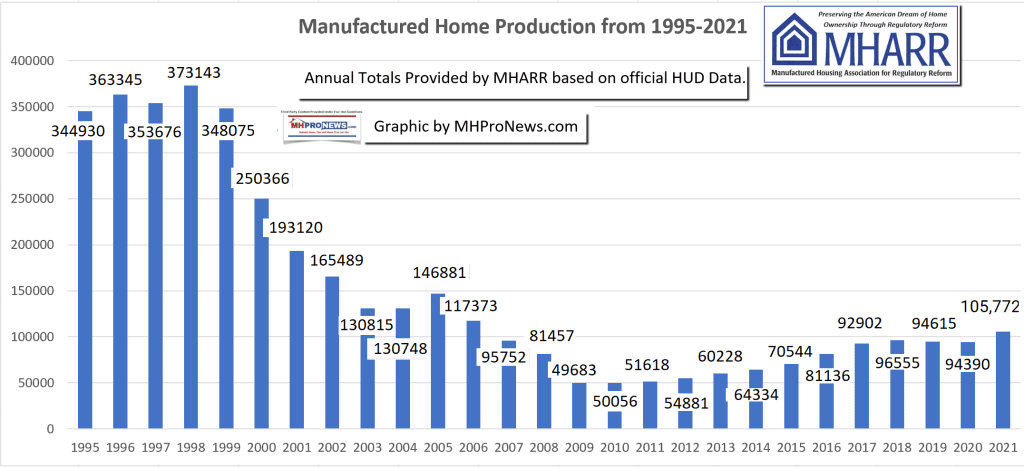
That the quality and value of manufactured homes are widely misunderstood has been well documented for decades. They are illustrated by these third-party references, which are buttressed by years of research in the collection that follows.


For whatever reasons, the Manufactured Housing Institute (MHI) has failed to publicly provide this type of information that has long been released on a monthly basis. By way of comparison to MHI, the National Association of Home Builders (NAHB), the National Association of Realtors (NAR), and the Recreational Vehicle Industry Association (RVIA) each publicly release and promote via news releases to the mainstream media their data monthly. Fortunately, the Manufactured Housing Association for Regulatory Reform has for years provided as well as publicly archived such data monthly. That information can be accessed by media, researchers and others at the link below.
https://manufacturedhousingassociationregulatoryreform.org/category/manufactured-home-shipments/
Often near the top reason for buying a modern manufactured home is affordability. But for informed affordable housing seekers, federally assured consumer protection law that applies to manufactured homes should be another good reason. Additionally, once common myths have been debunked by third-party research, as will be linked further below.
The U.S. Census Bureau’s most recent home selling price nationally and by region research are found below. This will give prospective housing shoppers an insight into the type of cost is involved in the manufactured home itself. Obviously, lot/land and site/utility costs should be added to these figures.
| Average Sales Price of New Manufactured Homes by Region and Size of Home | |||||||||||||||||||
| By Month of Shipment | |||||||||||||||||||
| (Dollars) | |||||||||||||||||||
| United States | |||
| Total1 | Single | Double | |
| 2021 | |||
| November | $111,900 | 76,400 | 139,900 |
| October | 112,000 | 81,700 | 138,200 |
| September | 118,300 | 78,800 | 141,300 |
| August | 112,000 | 80,000 | 138,000 |
| July | 118,700 | 76,000 | 137,800 |
| June | 106,800 | 70,200 | 128,100 |
| May | 106,500 | 69,900 | 128,300 |
| April | 100,200 | 66,700 | 122,500 |
| March | 98,100 | 63,300 | 123,200 |
| February | 98,300 | 65,400 | 122,500 |
| January | 95,000 | 64,100 | 118,500 |
| Northeast | |||
| Total1 | Single | Double | |
| 2021 | |||
| November | $100,900 | 71,600 | 133,500 |
| October | 110,300 | 74,400 | 138,700 |
| September | 102,100 | 76,100 | 124,100 |
| August | 105,000 | 86,000 | 117,000 |
| July | 98,500 | 74,100 | 125,700 |
| June | 101,600 | 73,700 | 124,200 |
| May | 98,400 | 69,900 | 121,500 |
| April | 95,900 | 73,800 | 113,300 |
| March | 91,400 | 58,600 | 121,300 |
| February | 88,300 | 59,400 | 113,800 |
| January | 102,600 | 67,900 | 116,200 |
| Midwest | |||
| Total1 | Single | Double | |
| 2021 | |||
| November | $107,300 | 78,100 | 143,800 |
| October | 101,000 | 81,000 | 132,600 |
| September | 109,300 | 80,900 | 142,300 |
| August | 100,000 | 77,000 | 132,000 |
| July | 110,500 | 79,100 | 139,300 |
| June | 94,900 | 65,600 | 125,800 |
| May | 94,300 | 67,500 | 128,200 |
| April | 85,400 | 61,800 | 125,400 |
| March | 86,400 | 60,800 | 119,100 |
| February | 87,300 | 62,400 | 118,100 |
| January | 83,000 | 62,100 | 112,700 |
| South | |||
| Total1 | Single | Double | |
| 2021 | |||
| November | $110,700 | 77,000 | 138,400 |
| October | 110,700 | 81,900 | 136,400 |
| September | 119,300 | 78,500 | 142,200 |
| August | 112,000 | 80,000 | 139,000 |
| July | 119,200 | 74,500 | 137,100 |
| June | 107,500 | 70,700 | 128,000 |
| May | 109,900 | 70,600 | 129,200 |
| April | 100,400 | 67,700 | 122,200 |
| March | 98,100 | 63,700 | 122,400 |
| February | 98,100 | 67,100 | 121,800 |
| January | 94,000 | 64,600 | 117,300 |
| West | |||
| Total1 | Single | Double | |
| 2021 | |||
| November | $128,800 | 68,400 | 145,500 |
| October | 131,600 | 85,000 | 150,400 |
| September | 132,100 | 76,200 | 141,600 |
| August | 135,000 | 79,000 | 143,000 |
| July | 131,100 | 81,700 | 142,800 |
| June | 116,400 | 72,200 | 131,500 |
| May | 104,400 | 70,300 | 125,500 |
| April | 118,400 | 65,000 | 125,000 |
| March | 113,000 | 67,300 | 130,800 |
| February | 116,900 | 60,900 | 131,900 |
| January | 113,400 | 62,300 | 129,500 |
| 1 Includes manufactured homes with more than two sections. |
| Note: Estimates include manufactured homes that are sold and those intended for sale for residential use. |
| Source: These data are produced by the U.S. Commerce Department’s Census Bureau from a survey sponsored by the U.S. Department of Housing and Urban Development. | ||||||||||
The Institute for Building Technology & Safety? (IBTS) gathers information on behalf of the U.S. Department of Housing and Urban Development (HUD). The official data by state is shown in the chart below.
| Institute for Building Technology & Safety (IBTS) | ||||||
| Shipments and Production Summary Report 03/01/2022 – 03/31/2022 | ||||||
| Shipments | ||||
| State | SW | MW | Total | Floors |
| Dest. Pending | 4 | 13 | 17 | 30 |
| Alabama | 237 | 291 | 528 | 819 |
| Alaska | 0 | 0 | 0 | 0 |
| Arizona | 61 | 181 | 242 | 427 |
| Arkansas | 95 | 109 | 204 | 313 |
| California | 55 | 307 | 362 | 687 |
| Colorado | 85 | 54 | 139 | 194 |
| Connecticut | 4 | 12 | 16 | 28 |
| Delaware | 21 | 36 | 57 | 93 |
| District of Columbia | 0 | 0 | 0 | 0 |
| Florida | 195 | 599 | 794 | 1,410 |
| Georgia | 148 | 334 | 482 | 817 |
| Hawaii | 0 | 0 | 0 | 0 |
| Idaho | 14 | 48 | 62 | 112 |
| Illinois | 77 | 46 | 123 | 170 |
| Indiana | 179 | 77 | 256 | 334 |
| Iowa | 27 | 17 | 44 | 61 |
| Kansas | 68 | 27 | 95 | 122 |
| Kentucky | 128 | 273 | 401 | 674 |
| Louisiana | 277 | 255 | 532 | 789 |
| Maine | 40 | 52 | 92 | 144 |
| Maryland | 12 | 10 | 22 | 32 |
| Massachusetts | 6 | 15 | 21 | 36 |
| Michigan | 126 | 150 | 276 | 426 |
| Minnesota | 53 | 52 | 105 | 157 |
| Mississippi | 221 | 236 | 457 | 693 |
| Missouri | 88 | 122 | 210 | 332 |
| Montana | 24 | 29 | 53 | 82 |
| Nebraska | 23 | 2 | 25 | 27 |
| Nevada | 12 | 78 | 90 | 171 |
| New Hampshire | 8 | 18 | 26 | 44 |
| New Jersey | 37 | 25 | 62 | 87 |
| New Mexico | 64 | 90 | 154 | 245 |
| New York | 83 | 102 | 185 | 287 |
| North Carolina | 264 | 399 | 663 | 1,063 |
| North Dakota | 11 | 19 | 30 | 49 |
| Ohio | 136 | 76 | 212 | 288 |
| Oklahoma | 112 | 125 | 237 | 363 |
| Oregon | 20 | 145 | 165 | 316 |
| Pennsylvania | 108 | 123 | 231 | 354 |
| Rhode Island | 0 | 0 | 0 | 0 |
| South Carolina | 180 | 364 | 544 | 912 |
| South Dakota | 12 | 15 | 27 | 42 |
| Tennessee | 96 | 270 | 366 | 636 |
| Texas | 1,037 | 1,084 | 2,121 | 3,215 |
| Utah | 4 | 32 | 36 | 68 |
| Vermont | 9 | 3 | 12 | 15 |
| Virginia | 64 | 65 | 129 | 194 |
| Washington | 5 | 152 | 157 | 321 |
| West Virginia | 35 | 85 | 120 | 205 |
| Wisconsin | 44 | 30 | 74 | 104 |
| Wyoming | 17 | 6 | 23 | 30 |
| Canada | 0 | 0 | 0 | 0 |
| Puerto Rico | 0 | 0 | 0 | 0 |
| Total | 4,626 | 6,653 | 11,279 | 18,018 |
| THE ABOVE STATISTICS ARE PROVIDED AS A MONTHLY | ||||
| SUBSCRIPTION SERVICE. REPRODUCTION IN PART OR | ||||
| IN TOTAL MUST CARRY AN ATTRIBUTION TO IBTS, INC. | ||||
| Production | ||||||||
| State | SW | MW | Total | Floors | ||||
| States Shown(*) | 448 | 492 | 940 | 1,437 | ||||
| Alabama | 733 | 981 | 1,714 | 2,698 | ||||
| *Alaska | 0 | 0 | 0 | 0 | ||||
| Arizona | 44 | 251 | 295 | 553 | ||||
| *Arkansas | 0 | 0 | 0 | 0 | ||||
| California | 62 | 268 | 330 | 611 | ||||
| *Colorado | 0 | 0 | 0 | 0 | ||||
| *Connecticut | 0 | 0 | 0 | 0 | ||||
| *Delaware | 0 | 0 | 0 | 0 | ||||
| *District of Columbia | 0 | 0 | 0 | 0 | ||||
| Florida | 74 | 333 | 407 | 753 | ||||
| Georgia | 197 | 616 | 813 | 1,435 | ||||
| *Hawaii | 0 | 0 | 0 | 0 | ||||
| Idaho | 24 | 136 | 160 | 302 | ||||
| *Illinois | 0 | 0 | 0 | 0 | ||||
| Indiana | 648 | 340 | 988 | 1,329 | ||||
| *Iowa | 0 | 0 | 0 | 0 | ||||
| *Kansas | 0 | 0 | 0 | 0 | ||||
| *Kentucky | 0 | 0 | 0 | 0 | ||||
| *Louisiana | 0 | 0 | 0 | 0 | ||||
| *Maine | 0 | 0 | 0 | 0 | ||||
| *Maryland | 0 | 0 | 0 | 0 | ||||
| *Massachusetts | 0 | 0 | 0 | 0 | ||||
| *Michigan | 0 | 0 | 0 | 0 | ||||
| Minnesota | 47 | 78 | 125 | 203 | ||||
| *Mississippi | 0 | 0 | 0 | 0 | ||||
| *Missouri | 0 | 0 | 0 | 0 | ||||
| *Montana | 0 | 0 | 0 | 0 | ||||
| *Nebraska | 0 | 0 | 0 | 0 | ||||
| *Nevada | 0 | 0 | 0 | 0 | ||||
| *New Hampshire | 0 | 0 | 0 | 0 | ||||
| *New Jersey | 0 | 0 | 0 | 0 | ||||
| *New Mexico | 0 | 0 | 0 | 0 | ||||
| *New York | 0 | 0 | 0 | 0 | ||||
| North Carolina | 126 | 350 | 476 | 830 | ||||
| *North Dakota | 0 | 0 | 0 | 0 | ||||
| *Ohio | 0 | 0 | 0 | 0 | ||||
| *Oklahoma | 0 | 0 | 0 | 0 | ||||
| Oregon | 25 | 281 | 306 | 604 | ||||
| Pennsylvania | 248 | 368 | 616 | 984 | ||||
| *Rhode Island | 0 | 0 | 0 | 0 | ||||
| *South Carolina | 0 | 0 | 0 | 0 | ||||
| *South Dakota | 0 | 0 | 0 | 0 | ||||
| Tennessee | 617 | 902 | 1,519 | 2,421 | ||||
| Texas | 1,333 | 1,257 | 2,590 | 3,858 | ||||
| *Utah | 0 | 0 | 0 | 0 | ||||
| *Vermont | 0 | 0 | 0 | 0 | ||||
| *Virginia | 0 | 0 | 0 | 0 | ||||
| *Washington | 0 | 0 | 0 | 0 | ||||
| *West Virginia | 0 | 0 | 0 | 0 | ||||
| *Wisconsin | 0 | 0 | 0 | 0 | ||||
| *Wyoming | 0 | 0 | 0 | 0 | ||||
| *Canada | 0 | 0 | 0 | 0 | ||||
| *Puerto Rico | 0 | 0 | 0 | 0 | ||||
| Total | 4,626 | 6,653 | 11,279 | 18,018 | ||||
| (*) THESE STATES HAVE FEWER THAN THREE PLANTS. | ||||||||
| FIGURES ARE AGGREGATED ON FIRST LINE ABOVE TOTALS TO PROTECT PROPRIETARY INFORMATION. | ||||||||
|
||||||||

Depending on sources, the number of housing units of all types needed in the U.S. is estimated to be between 4 million to 8+ million units. As the NAR has said, there has been an annual shortfall for several years between population growth and the number of housing units built. There is no simple way for conventional construction to ‘catch up’ with or close that gap.
Indeed, in a 2021 report in MarketPlace, conventional site-builders admitted that they are ‘throttling’ construction and their use of developed lots.
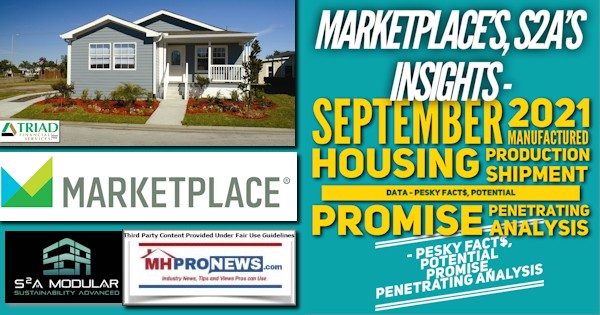
For years, the solution to the need for more housing has been known. In 2018, the Urban Institute in research on modern manufactured housing correctly noted that manufactured homes could play a far more important part in solving the affordable housing crisis. They asked the obvious question. Why aren’t more manufactured homes being sold?

The Urban Institute researchers aptly identified zoning and placement barriers and the lack of competitive financing as being among the reasons for the industry’s underperformance for years.
HUD’s Office of Policy Development and Research (PD&R) associates Pamela Blumenthal and Regina Gray on 9.7.2021 posted on a HUD website their discussion on “the impact of regulatory barriers on housing affordability.” Very little attention, other than from MHLivingNews, our MHProNews.com sister-site, and op-eds by this author to other news publications has been paid to Blumenthal’s and Gray’s keen statements. These pull quotes and graphics speak volumes. The emphasis is added by MHLivingNews, but the text is as in the original. Each bullet is a quote from their research report summary.
The consequences of inadequate supply are higher housing costs for both renting and buying a home. More than 37 million renter and owner households spent more than 30 percent of their income for housing in 2019.
- Without significant new supply, cost burdens are likely to increase as current home prices reach all-time highs, with the median home sales price reaching nearly $375,000 by July 2021. These data emphasize the urgency of employing opportunities for increasing the supply of housing and preserving the existing housing portfolio.
- The regulatory environment — federal, state, and local — that contributes to the extensive mismatch between supply and need has worsened over time. Federally sponsored commissions, task forces, and councils under both Democratic and Republican administrations have examined the effects of land use regulations on affordable housing for more than 50 years. Numerous studies find land use regulations that limit the number of new units that can be built or impose significant costs on development through fees and long approval processes drive up housing costs. Research indicates higher housing costs also drive up program costs for federal assistance, reducing the funds available to serve additional households.
What Blumenthal and Gray failed to mention at all is manufactured housing. At best, that’s odd, because HUD has the primary federal jurisdiction over the HUD Code manufactured housing program.
Recently released comments by Professor James A. “Jim” Schmitz Jr, with the University of Minnesota, to the Department of Justice (DoJ) sheds a deeper light into what has been occurring, per his research studies. Said Schmitz, federal officials have teamed up with builders and HUD to undermine or “sabotage” the factory-built manufactured housing market.

Schmitz said that this has been occurring for decades. He cited the work of prior Justice Department antitrust officials who ‘tried to protect’ factory-built home production, well before the modern manufactured home era. The report linked above is a useful summary. But the entire Schmitz statement to the DoJ is found in the article linked below. As Schmitz said, ‘Monopolies Inflict Harm in Many Ways” that are “Sabotaging” manufactured homes through regulatory interference.
That is obviously stated in different way than Gray and Blumenthal phrased it, but they are each making similar and arguably complimentary points. Those points buttress what the Urban Institute said, referenced and linked above.
It should be noted that prior HUD Secretary Dr. Benjamin “Ben” Carson, M.D., pledged a “new era of cooperation” between HUD and the manufactured housing industry. What happened to that sweet sounding pledge? Why has the Biden Administration’s Secretary Marcia Fudge provided lip service instead of support for modern HUD Code manufactured homes, contrary to Carson’s assurances?
The Vexing Truth is Hiding in Plain Sight
On paper, MHI and MHARR often seem to say similar things when it comes to manufactured housing related issues. MHI is by far the larger of the two trade groups. MHI claims to represent “all segments” of manufactured housing, which means both production and post-production issues. Production issues are those connected to the building or producing of manufactured housing as it relates to primarily federal regulators. Post-production issues are those which deal with issues such as zoning, placement, financing, or educational/marketing types of topics.
As the quote graphic reveals, MHI’s CEO Lesli Gooch, Ph.D., has said that HUD has failed to implement its authority to overcome zoning and placement barriers. That authority, Gooch has aptly said, flows from the Manufactured Housing Improvement Act of 2000 (MHIA or 2000 Reform Law). MHARR’s Mark Weiss, J.D. has said similarly, as is also illustrated in that same quotation graphic. But MHARR has also reminded their readers and public officials that Democratic lawmakers who were part of the widely bipartisan coalition for passing the MHIA made what industry sources refer to as “enhanced preemption” part of the MHIA law. Those lawmakers stressed to prior HUD Secretary Mel Martinez that HUD has authority and should use it to overcome the kinds of problems that Blumenthal and Gray have described some 18 years later.
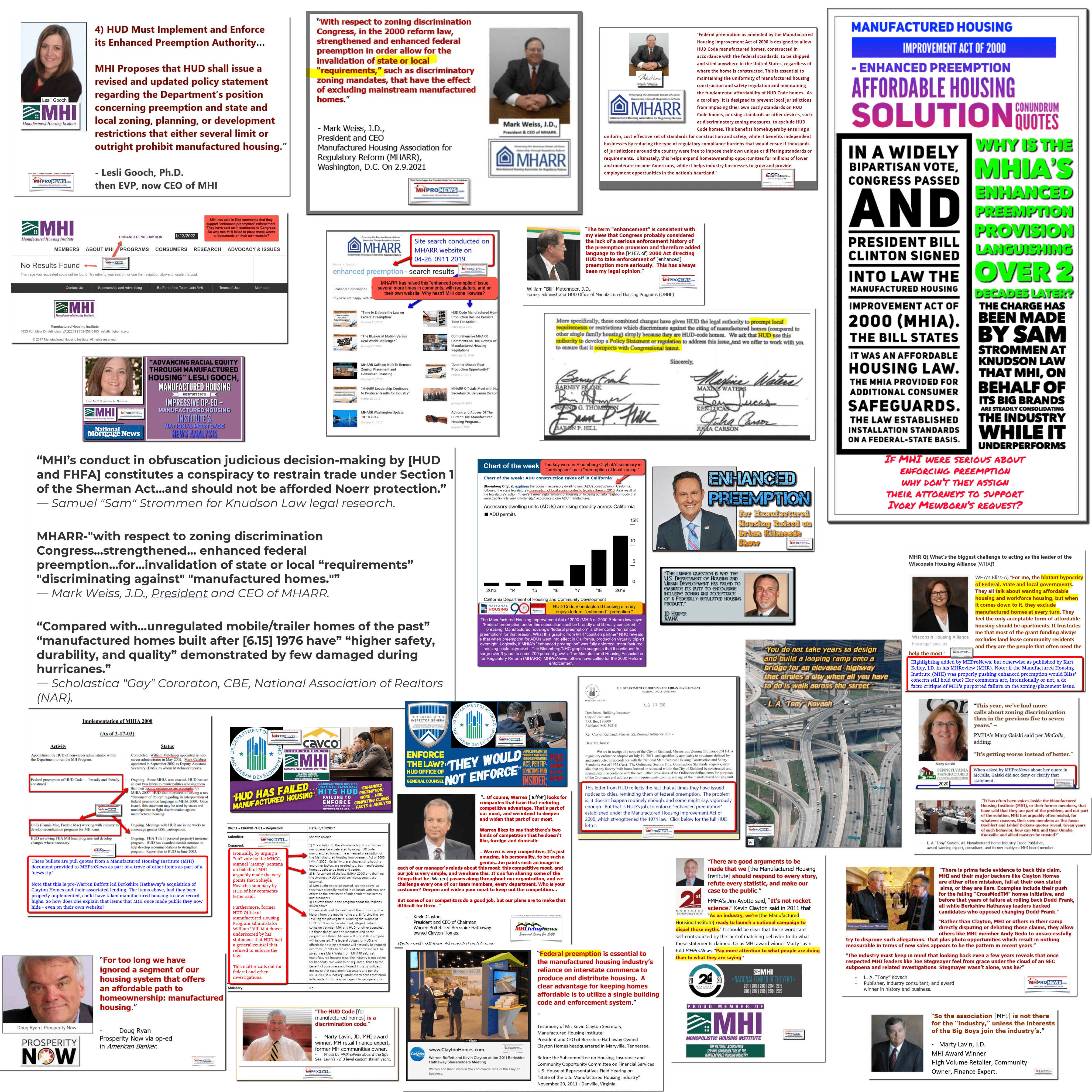
But this is where the seeming similarities in the words uttered by MHI and MHARR are apparently different in practice. As an MHI insider has charged, MHI is being controlled by ‘f-cking greedy, selfish leaders of [larger] companies’ that have made ‘MHI a tool for enriching themselves.’ It is interesting to note that the insider that told that to MHProNews.com did so in the context of the post-Chris Stinebert, a prior president and CEO at MHI, at that Arlington, VA based trade organization.
The law-professor reviewed legal research thesis by Samuel Strommen at Knudson Law makes eerily similar allegations that fit the allegations that MHARR, some MHI insiders like those cited in the article linked above, Schmitz and his colleagues have asserted. While each may emphasize something different, their various evidence-based allegations are complimentary, much like pieces of a puzzle.
As lawmakers at the state level in the Midwest and Rockies have again been accused by manufactured home community residents of watering down ‘protections’ for residents who find themselves living in communities that are operated by “predatory” companies, the importance of Strommen’s and Schmitz’s respective arguments come into focus. Namely, in order to get more affordable housing and to protect the interests of manufactured home residents in communities, antitrust efforts will be needed.
Putting the Puzzling Pieces of the Struggle for Affordable Housing and Manufactured Homes Together
The battle over monopolization, or antitrust and merger- and acquisition-related issues impacts affordable housing. Schmitz and his research colleagues have provided several important elements of that puzzle. They have identified the point that some public officials at HUD are clearly responsible, but then so too are those at DOJ and the Federal Trade Commission (FTC) who are supposed to be the antitrust watchdogs for our nation.
Schmitz and others who are involved in what might be called the antitrust or antimonopoly-power movement have pointed to previous eras of American history when the threat from “goliaths” were better known.
Two sources have told MHProNews that during the Trump Administration, top antitrust officials met to discuss problems in the manufactured housing industry. But with the change of power at the White House from Trump to Biden and a reshuffling of officials, there is no known indication at this time that similar emphasis will occur. Objectively, the Biden White House website also remarks about the problems that are roiling several sectors of the U.S. economy, not just housing or manufactured homes. But the question ought to be is this. Are Biden-era officials – perhaps akin to MHI’s purported behavior – merely talking a good talk without doing what needs to be done legally?
There is no known evidence that MHI has sought to legally press federal officials to enforce existing laws on antitrust, on the MHIA, or other laws that aimed to produce lower cost and better terms for manufactured home lending. When MHARR offered to team up with MHI state level affiliates in 2019 to legally seek enforcement of enhanced preemption, MHARR said none of the state affiliates accepted the offer.
Congress pressed such issues in 2011 and 2012, specifically looking into topics like enhanced preemption under the MHIA. MHLivingNews, MHProNews, and this writer have editorially noted that pressing these issues at the state attorney general level and through federal lawmakers in their oversight capacity might yield a probe into the ‘sabotaging monopolization’ of manufactured housing that is harming an array of housing seekers, not only those who want a modern manufactured home. Among the relevant points is the analysis of research by LendingTree on MHLivingNews revealed that manufactured homes are appreciating at a similar, and sometimes greater rate, in the last 5 years as conventional housing has.
###


Case Against Clayton Homes – Years of Legal & Regulatory Claims
That’s a wrap on this installment of “News through the lens of manufactured homes and factory-built housing” © where “We Provide, You Decide.” © ## (Affordable housing, manufactured homes, reports, fact-checks, analysis, and commentary. Third-party images or content are provided under fair use guidelines for media.) (See Related Reports, further below. Text/image boxes often are hot-linked to other reports that can be access by clicking on them.)

By L.A. “Tony” Kovach – for MHLivingNews.com.
Tony earned a journalism scholarship and earned numerous awards in history and in manufactured housing. For example, he earned the prestigious Lottinville Award in history from the University of Oklahoma, where he studied history and business management. He’s a managing member and co-founder of LifeStyle Factory Homes, LLC, the parent company to MHProNews, and MHLivingNews.com. This article reflects the LLC’s and/or the writer’s position, and may or may not reflect the views of sponsors or supporters.
Connect on LinkedIn: http://www.linkedin.com/in/latonykovach
Recent and Related Reports:
The text/image boxes below are linked to other reports, which can be accessed by clicking on them.
 manufacturedhomelivingnews.com Manufactured Home Living News
manufacturedhomelivingnews.com Manufactured Home Living News








